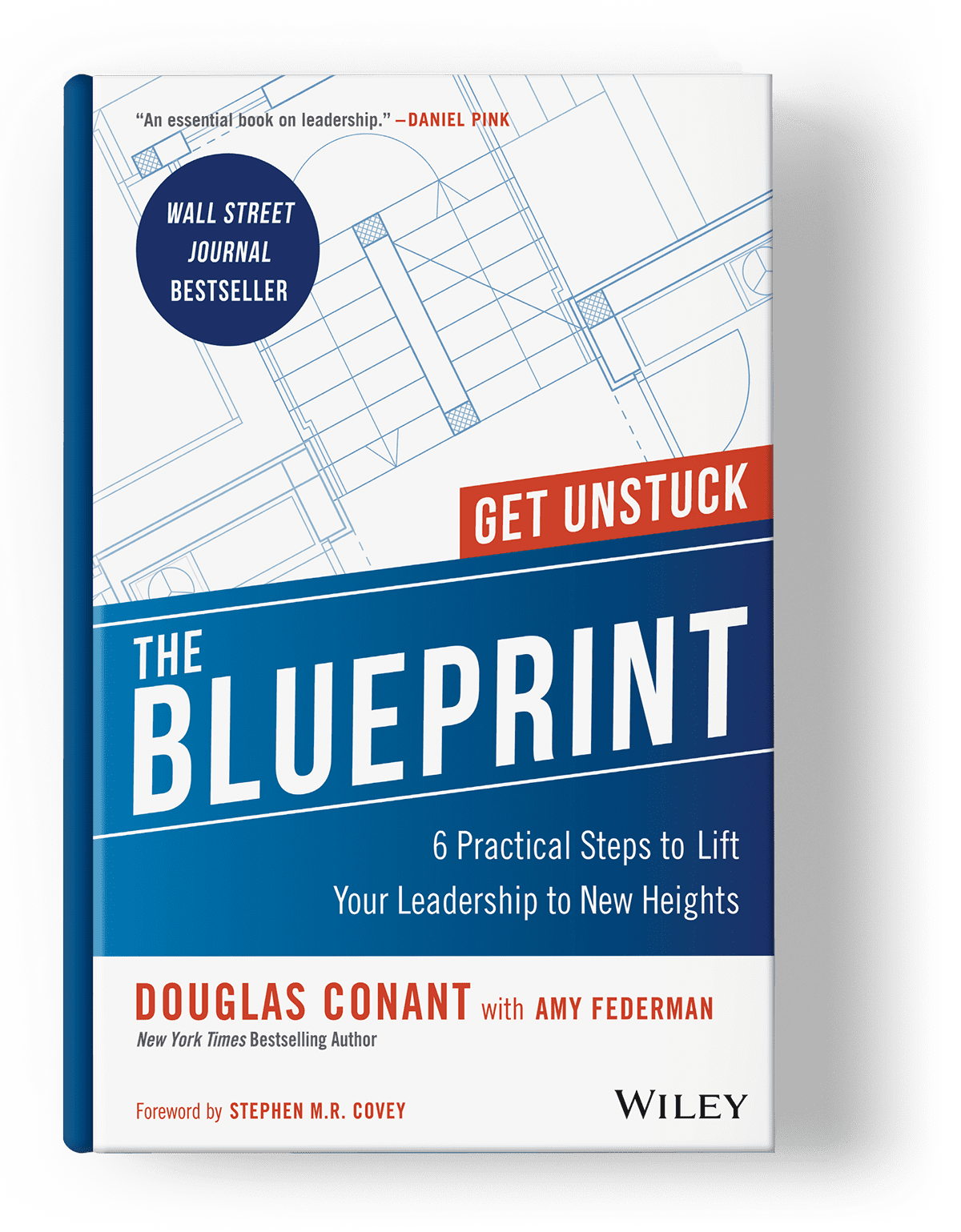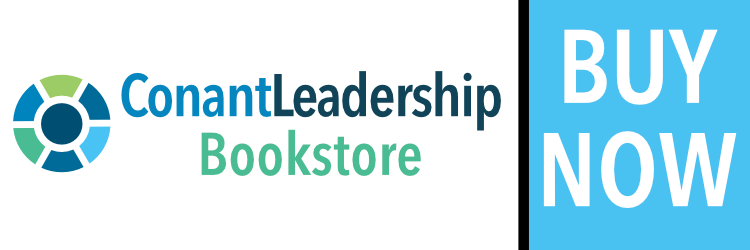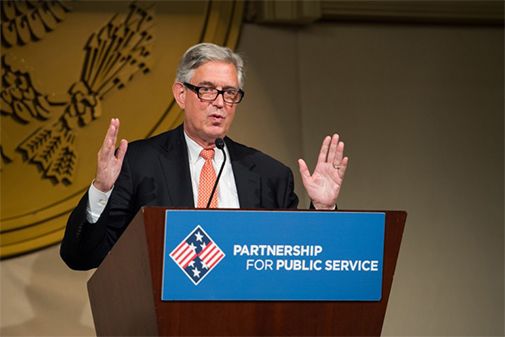This spring, ConantLeadership hosted the first ever BLUEPRINT Leadership Summit, a meeting of the top leadership minds and luminaries in the business space, inspired by the insights in the book, The Blueprint: 6 Practical Steps to Lift Your Leadership to New Heights.
At this landmark event, Bill George—Senior Fellow at Harvard Business School, former Board Chair & CEO of Medtronic, and bestselling author of “Discover Your True North,” and “Authentic Leadership”—talked with ConantLeadership Founder and author of The Blueprint, Doug Conant, about leadership in times of crisis.
Enjoy the following smart tips from Bill George and Doug Conant for leading authentically and finding your ‘True North’ in a tumultuous landscape.
(And you can watch the full video of this summit session on authentic leadership here.)
Do the (Inner) Work
“Before you change the world, you have to change yourself,” was one of the rallying cries from Bill George during the Summit. This idea of “inside, out” leadership —an approach to leading people that is anchored in a deep understanding of who you are and what you believe—is embraced by many leadership practitioners with a track record of success, and is central to both The Blueprint and to True North. Its power comes from the fact that when you are facing challenges in your leadership, you can remember the Blueprint’s mantra, “the only way ‘out’ is ‘in’,” and look inward for strength and guidance rather than flailing. But this only works if you have first done the necessary reflection to connect with your leadership purpose and beliefs.
Bill champions the importance of getting “grounded,” which requires doing “inner work” to figure out who you are so you can lead with both your “head and your heart.” He backs it up with Buddhist thinking, quoting an aphorism from Thich Nhat Hanh, a Buddhist monk: “The longest journey you’ll ever take is the 18 inches from your head to your heart.”
To take that journey, connect with people, and influence them to do great things for your organization—and for the world—he explains that you must go beyond intellectual study and learn to study yourself: “A lot of leaders go to school . . . they think they’re the smartest person in the world and just want to lead with their heads. And ultimately, they fail because they never capture the hearts of the people.” Why? Because they are not showing that they “have a heart” themselves with their actions and their leadership style.
While Bill calls upon Buddhist thinking, Doug turns to architecture and design thinking for inspiration in illustrating the power of inner work; his 6-step Blueprint process honors the fundamental engineering principles that help our greatest structures withstand mighty storms. He explains: Structural engineers know the trick to building a soaring skyscraper is laying a deep foundation. Without a sturdy foundation, buildings can topple under their own weight and may not be able to withstand natural disasters or high winds.
Doug knows the same principle applies in leadership, especially in times of turbulence. He says for “leaders to navigate these uncharted waters,” they must “build their own personal leadership foundation that honors both their expectations of themselves as well as the organization’s expectations.” And the incremental reflection exercises in “The Blueprint” enable you to do this little by little, without chasing perfection, in a way that nests into the crushing pace and responsibilities of modern life. Ultimately, getting anchored in your leadership foundation allows you to operate in a way that is “deeply personal, purpose-driven, and performance-oriented.” The best leaders have done the inner work, and you can too.
To Be Agile, You Must Show Clarity of Vision
The primary source of competitive advantage today, “is organization agility,” says Doug, “and it starts with leaders—because the world changes, and you have to adapt,” or your organization may cease to exist.
Bill and Doug agree that the twin trait that is equally important to agility is “courage.” Without the ability to take bold action that aligns with your convictions, you won’t be able to adapt as the business environment transforms. So how can leaders steward their teams with an equal mix of agility and courage? Both experts agree the key is showing “clarity of vision.”
Bill explains: “You can’t be agile unless you have a clear vision. It’s like you’re a sailor, and you’re heading somewhere on the sea. You better know where you’re going. When a storm hits, you better have a place you can point to that you know you’re trying to reach. That’s your vision . . . and if people are going to follow you, they have to have clarity about your vision and where you’re going.” Then, when “you’re buffeted by the winds back and forth,” you are able to use “agility to stay on course.” But, you can’t stay the course unless, “you have clarity about where you’re going.”
Bill uses Mary Barra, the CEO of General Motors (GM) as an example of a leader who is exemplifying these principles. Rather than being in denial about the disruptions to the automotive industry and to the changing expectations of consumers due to climate change, Barra is leading with an audacious vision. Recently, she announced that GM, the world’s largest auto maker, plans to produce and sell only zero-emission automobiles by 2035 and that by 2040, their global operations will be carbon-neutral. Bill says that Barra is also envisioning the requirements of the coming decades, designing self-driving cars and other innovations so the company will not be left behind as the world changes rapidly. And she’s got the courage to follow through: Despite some naysayers mocking her vision and deriding it as a PR stunt, she shows confidence in her agile vision. Bill says, “everyone in GM, including the unions, are lined up behind her because they know she will lead them to a positive future.”
Bill believes the lesson for leaders is clear: “You have to be that authentic person and you have to stand up, to stand in the fire, even though you’re going to get criticized,” and most of all, “have the courage to do the right thing.” If you want your organization to not only survive—but thrive— in tumultuous times, he says you must strive for the magic combination of “vision, authenticity, and courage.”
Doug adds that to be able to operate from a deep clarity of vision, it’s crucial to first be anchored in the strong foundation referenced in our experts’ first tip above; vision is so important to this territory that Doug purposely made “Envision” the first step in his 6-step Blueprint process which enables leaders to find the necessary clarity to lead with this potent triumvirate of traits (vision, authenticity, and courage).
Put People First by Leading with Listening
One of Doug’s mentors once said to him, “don’t step foot in a classroom unless you’re ready to learn from your students.” He says the same principle applies to leading people: “Don’t ever go into a company unless you’re ready to learn from your employees and all of your stakeholders.” To effect change, it’s always wise to put people first. Bill and Doug agree that you must learn to “lead with listening” if you ever hope to connect with people and make them feel valued—and to ensure you are being exposed to the best ideas for moving your company forward.
Bill shares that earlier in his career he was too focused on “selling” his ideas and being persuasive; he was overlooking other people’s perspectives. When he became a leader at Medtronic, a medical device company, he realized he didn’t have expertise in medical technology. To get oriented and be effective, Bill knew he would have to listen to the people doing the work. He says: “I went out and just started listening. The first thing I did was start visiting doctors. I saw over 700 procedures in my time in Medtronic, just to learn about the business firsthand and then bring that back to the company.” The most illuminating and valuable insights he gained were “not at some management meeting with a group of PowerPoint charts”; rather, they were “in the labs” with the employees. The process taught him how to listen and learn.
Bill’s advice to leaders who are trying to understand their business better is, “just go talk to people in the production line. They’ll tell you what the problems are.” The best way to expand your mind is to get out, be among the people, and tune in; “Stop preaching,” he advises, and start hearing what others are saying.
Doug’s experiences back up Bill’s observations and he agrees that, “CEOs today can’t just sit in their office and run their business.” He shares, “I learned a while back that I would be much better off if I sat and listened before I offered a point of view.” Because of this lesson he recommends, “getting out and connecting with associates.” It was an important revelation for him—an introvert—that personally engaging with people was the key to unlocking both better employee engagement and better performance. (His instinct previously had been to stay a bit more hidden.)
Doug learned this lesson doubly, and in even sharper focus, in the aftermath of his near-fatal car accident in 2009 while he was CEO of Campbell Soup Company. His doctor wanted him to move more during the day to help with his recuperation. And his assistant wanted him to have more face time with employees so they would feel reassured about his health and vitality. A perfect storm. Doug’s assistant devised a plan aligned with “heart health month,” where he would get his “10,000 steps” a day by walking around Campbell—and he would encourage associates to “get their steps,” too.
Even though Doug was shy and hesitant about the initiative, he grew to love these walks and began meeting more people in-person than ever before: “I started seeing them, the millennials, the Gen Xers, the executive assistants, everybody!” And even though he’d been CEO already for many years, his appreciation and understanding of the organization deepened: “I got such a visceral understanding of the pulse of what was going on in that company simply by walking around and connecting.” This was reinforcing to employee engagement too—getting face-time with the CEO of a large organization helped contributors at every level of the company to feel included and heard. The story crystallizes why every leader should heed the advice to “lead by listening.” It’s a win-win.
About the Author: Amy Federman is ConantLeadership’s Director of Content and Editor in Chief and co-author with Doug Conant of the WSJ bestseller, The Blueprint.
Enjoyed these insights? For even more on authentic leadership, explore the full video recording of this summit session here, engage with our suite of written leadership resources here, or start your Blueprint journey by getting your signed copy of the book here.
Ready to step into your full leadership potential? Apply to our signature leadership development program, The BLUEPRINT Boot Camp by ConantLeadership, a 2-day leadership intensive offering elite level, highly interactive training with Doug Conant and a community of your leadership peers. Learn more about this premium tier of transformational leadership development here or set up a complimentary consultation call here.
(Cover photo by Jehyun Sung on Unsplash)






0 Comments